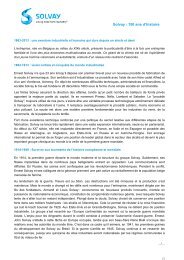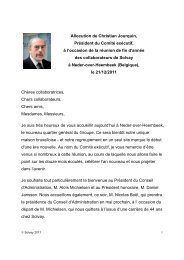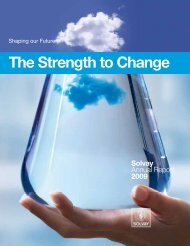solvay_live243_p02a04 somEdito
solvay_live243_p02a04 somEdito
solvay_live243_p02a04 somEdito
Create successful ePaper yourself
Turn your PDF publications into a flip-book with our unique Google optimized e-Paper software.
Dossier SolvayInnovationTrophy2006<br />
104190<br />
22<br />
PVC AND NATURAL FIBERS COMPOSITES:<br />
A SYNERGISTIC MARRIAGE<br />
THE BEST OF BOTH WORLDS<br />
PVC is without a doubt the most widely used<br />
plastic in the home. It is therefore only<br />
logical that it should meet the expectations<br />
of consumers, who are becoming increasingly<br />
demanding when it comes to design<br />
and aesthetic innovations.<br />
Hence the idea of setting up a marriage<br />
between PVC and natural fibre composites<br />
to make the most of two worlds: the<br />
properties of PVC (low maintenance, good<br />
stability in humid conditions, very good<br />
reaction to fire, flexibility in terms of shapes<br />
and colours) can be harmoniously combined<br />
with the characteristics of natural fibres<br />
(pleasant appearance, feel and even odour<br />
of the wood and other fibres, tried and tested<br />
rigidity, good stability for external uses).<br />
The innovation consisted of the development,<br />
in partnership with the fibre suppliers<br />
and the clients, of shaped interior and exterior<br />
materials but also injection moulds and films.<br />
These materials can be handled as easily<br />
as PVC (without the need for any specific<br />
equipment), can be worked like wood (they<br />
can be sawn and nailed) and can be recycled<br />
in the same application without losing their<br />
properties. Furthermore, as they contain 20 to<br />
60% of natural fibres (including wood waste)<br />
they help preserve non-renewable resources.<br />
These kinds of wood-like composites are<br />
already used in the US and are starting to gain<br />
a foothold on the European market, offering<br />
a promising potential for commercial<br />
development.<br />
> Claudine Bloyaert; Jean-François Cart; Xavier Coudry;<br />
Dirk Dompas; Saramas Duangport; Isabelle Georges-<br />
Guerand; Pierre Lomenech; Jean-Louis Lorand;<br />
Carmelo Ricci; Wuthilaohaphan Siriporn; Richard<br />
Thommeret; Alain Wyart.<br />
> SBU VINYLS<br />
104761<br />
TSBM IS A NEW METHOD FOR PRODUCING FUEL<br />
SYSTEM WITH FULL INTEGRATION OF COMPONENT<br />
A DECISIVE STEP<br />
TOWARDS SUPREMACY<br />
The PZEV (Partial Zero Emission Vehicle)<br />
was imposed in 2005 in certain American<br />
States. Inergy took up the gauntlet and<br />
developed TSBM (Twin Sheet Blow Molding)<br />
as an answer to the generalization of this<br />
regulation. Quite an achievement, as it not<br />
only offers advantages in terms of a<br />
reduction in pollution (emissions and noise)<br />
but also cuts costs. The manufacturing<br />
process developed allows molding and blow<br />
molding in one single step, along with the<br />
simultaneous integration of all of the system<br />
components. The TSBM is the fruit of an<br />
intense partnership between R&D (pilot line<br />
in NOH between 2003 and 2005),<br />
the industrial departments, the development<br />
centres of the clients and external suppliers.<br />
After conducting various tests on the<br />
prototype and validating the industrial<br />
procedures, the tool will be transferred<br />
to Rottenburg in 2007. Inergy is expecting<br />
to sell up to 3.4 million units of its system in<br />
2012 and will do so by increasing by half the<br />
number of new markets, in particular in Asia<br />
where its strategic clients are concentrated.<br />
They are already showing strong interest:<br />
in addition to the various aforementioned<br />
reductions, the TSBM will allow them<br />
to increase the useful fuel volume of their<br />
vehicles, to more easily integrate the various<br />
components into fuel systems with a reduced<br />
number of connections and thus simplify<br />
the assembly lines. The TSBM process is so<br />
revolutionary that is paves the way for<br />
the development of new components for<br />
the fuel systems of the future, sounding<br />
the knell of steel tanks.<br />
> Bjorn Criel; Mireille Paulus; Philippe Bournonville;<br />
Pascal Dehenau; Franck Dhaussy; Serge Dupont;<br />
Daniel Hayot; Frédéric Jannot; Hervé Lemoine;<br />
Richard Lesschaeve; Barbara Mabed;<br />
Philippe Martin; Pierre-François Tardy.<br />
> SBU INERGY<br />
105040<br />
VITALOA: LET’S FEEL BETTER!<br />
NUTRITION: OPENING<br />
NEW HORIZONS<br />
In a sector where scientific rigueur is a key<br />
success factor, Vitaloa aims at producing<br />
and selling nutritional ingredients that are<br />
beneficial to our health. The first target<br />
segments are the intestinal transit, the<br />
mineral balance and the weight control.<br />
The project is developed in cooperation<br />
between Lactalis, the leading cheese<br />
company in Europe and the second largest in<br />
the field of fresh dairy products, bringing its<br />
knowledge of the food industry and market<br />
access, and Solvay, contributing both with a<br />
raw material and with its<br />
pharmaceutical/health expertise.<br />
Vitaloa is based on a particular disaccharide<br />
resistant to gastro-enzymes of which Solvay<br />
Pharmaceuticals is the leading producer<br />
world-wide – the GalactoFructose or<br />
lactulose (DUPHALAC ® ). Vitaloa can be a<br />
launching pad for Solvay to develop in a new<br />
and growing market. The scientific and<br />
pharmaceutical foundations of Solvay,<br />
combined with the experience of Lactalis<br />
create a simple recipe meant to succeed.<br />
> Pascal Ronfard; Baerbel Grams; Chantal Heroux;<br />
Perrine Immer; Jean-Jacques Maugas; Marc Welz.<br />
> NBD


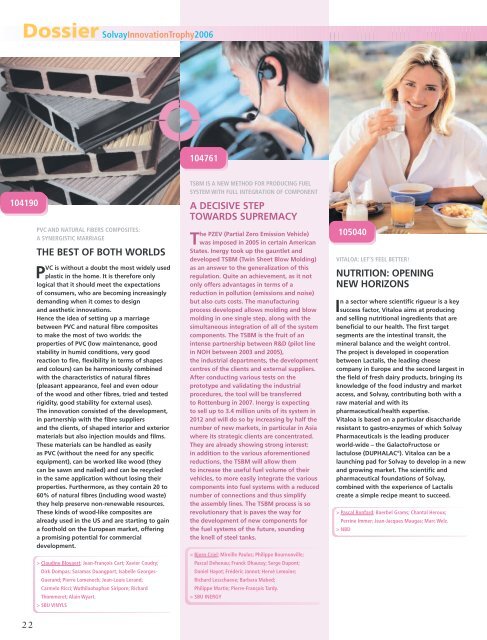

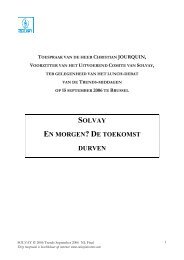
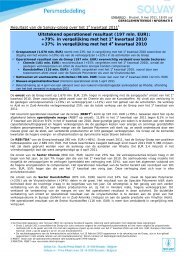

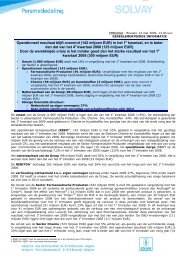
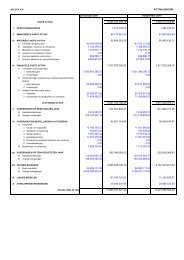

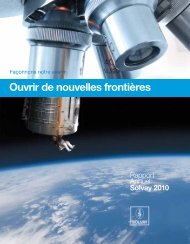
![PROC.1 [LETTRE] - Solvay](https://img.yumpu.com/16585746/1/184x260/proc1-lettre-solvay.jpg?quality=85)
